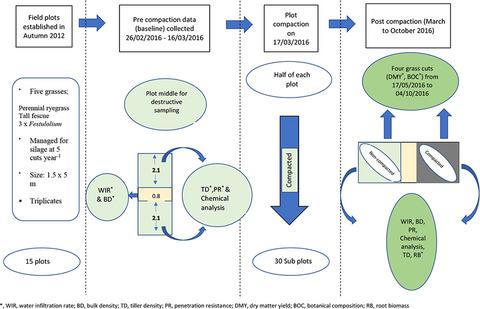当前位置:
X-MOL 学术
›
Food Energy Secur.
›
论文详情
Our official English website, www.x-mol.net, welcomes your feedback! (Note: you will need to create a separate account there.)
Do agricultural grasses bred for improved root systems provide resilience to machinery‐derived soil compaction?
Food and Energy Security ( IF 5 ) Pub Date : 2020-07-05 , DOI: 10.1002/fes3.227 Nuwan P K Muhandiram 1 , Mike W Humphreys 1 , Rhun Fychan 1 , John W Davies 1 , Ruth Sanderson 1 , Christina L Marley 1
Food and Energy Security ( IF 5 ) Pub Date : 2020-07-05 , DOI: 10.1002/fes3.227 Nuwan P K Muhandiram 1 , Mike W Humphreys 1 , Rhun Fychan 1 , John W Davies 1 , Ruth Sanderson 1 , Christina L Marley 1
Affiliation

|
The increasing frequency of droughts and floods on grasslands, due to climate change, increases the risk of soil compaction. Soil compaction affects both soil and forage productivity. Differing grasses may counteract some effects of compaction due to differences in their root architecture and ontogeny. To compare their resilience to soil compaction, three Festulolium (ryegrass and fescue species’ hybrids) forage grass cultivars comprising differing root architecture and ontogeny were compared in replicated field plots, together with a ryegrass and tall fescue variety as controls. Pre‐compaction soil and forage properties were determined in spring using > four‐year‐old plots to generate baseline data. Half of each field plot was then artificially compacted using farm machinery. Forage dry matter yield (DMY) was determined over four cuts. After the final harvest, post compaction soil characteristics and root biomass (RB) were compared between grasses in the non‐compacted and compacted soils. Pre‐compaction data showed that soil under Festulolium and ryegrass had similar water infiltration rates, higher than soil under tall fescue plots. Tiller density of the Festulolium at this time was significantly higher than fescue but not the ryegrass control. Forage DMY was significantly lower (p < .001) with compacted soil at the first cut but, by the completion of the growing season, there was no effect of soil compaction on total DMY. Tall fescue had a higher total DMY than other grasses, which all produced similar annual yields. Soil bulk density and penetration resistance were higher, and grass tiller density was lower in compacted soils. Root biomass in compacted soils showed a tendency for Festulolium cv Lp × Fg to have higher RB than the ryegrass at 0–15 cm depth. Overall, findings showed alternative grass root structures provide differing resilience to machinery compaction, and root biomass production can be encouraged without negative impacts on forage productivity.
中文翻译:

为改善根系而培育的农用草是否能够抵抗机械造成的土壤压实?
由于气候变化,草原干旱和洪水的发生频率不断增加,增加了土壤板结的风险。土壤压实影响土壤和饲料生产力。由于根部结构和个体发育的差异,不同的草可能会抵消压实的一些影响。为了比较它们对土壤压实的恢复能力,在重复的田间试验中比较了三种羊茅草品种(黑麦草和羊茅品种的杂交种),其中包括不同的根结构和个体发育,以及作为对照的黑麦草和高羊茅品种。春季使用超过四年的地块来确定预压实土壤和饲料特性,以生成基线数据。然后使用农业机械对每块田地的一半进行人工压实。草料干物质产量(DMY)通过四次切割测定。最终收获后,比较了非压实和压实土壤中草的压实后土壤特性和根生物量(RB)。预压实数据显示,羊茅和黑麦草下的土壤具有相似的水入渗率,但高于高羊茅地块下的土壤。此时羊茅的分蘖密度显着高于羊茅,但不高于黑麦草对照。第一次收割时土壤压实,饲料 DMY 显着降低 ( p < .001),但到生长季节结束时,土壤压实对总 DMY 没有影响。高羊茅的总 DMY 高于其他禾本科植物,而其他禾本科植物的年产量都相似。压实土壤的土壤容重和渗透阻力较高,草蘖密度较低。压实土壤中的根系生物量显示,在 0-15 cm 深度, Festulolium cv Lp × Fg 具有比黑麦草更高的 RB。总体而言,研究结果表明,替代的基层结构对机械压实提供了不同的弹性,并且可以鼓励根部生物量的生产,而不会对饲料生产率产生负面影响。
更新日期:2020-07-05
中文翻译:

为改善根系而培育的农用草是否能够抵抗机械造成的土壤压实?
由于气候变化,草原干旱和洪水的发生频率不断增加,增加了土壤板结的风险。土壤压实影响土壤和饲料生产力。由于根部结构和个体发育的差异,不同的草可能会抵消压实的一些影响。为了比较它们对土壤压实的恢复能力,在重复的田间试验中比较了三种羊茅草品种(黑麦草和羊茅品种的杂交种),其中包括不同的根结构和个体发育,以及作为对照的黑麦草和高羊茅品种。春季使用超过四年的地块来确定预压实土壤和饲料特性,以生成基线数据。然后使用农业机械对每块田地的一半进行人工压实。草料干物质产量(DMY)通过四次切割测定。最终收获后,比较了非压实和压实土壤中草的压实后土壤特性和根生物量(RB)。预压实数据显示,羊茅和黑麦草下的土壤具有相似的水入渗率,但高于高羊茅地块下的土壤。此时羊茅的分蘖密度显着高于羊茅,但不高于黑麦草对照。第一次收割时土壤压实,饲料 DMY 显着降低 ( p < .001),但到生长季节结束时,土壤压实对总 DMY 没有影响。高羊茅的总 DMY 高于其他禾本科植物,而其他禾本科植物的年产量都相似。压实土壤的土壤容重和渗透阻力较高,草蘖密度较低。压实土壤中的根系生物量显示,在 0-15 cm 深度, Festulolium cv Lp × Fg 具有比黑麦草更高的 RB。总体而言,研究结果表明,替代的基层结构对机械压实提供了不同的弹性,并且可以鼓励根部生物量的生产,而不会对饲料生产率产生负面影响。



























 京公网安备 11010802027423号
京公网安备 11010802027423号